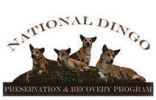Victorian government captive to farm sector propaganda - farm stock predation wildly exaggerated
 The National Dingo Preservation and Recover Program (NDPRP) today congratulated the Victorian government for recent progressive policy initiatives regarding dingo conservation in that state. This has included recognition of aspirations for protection of the dingo by Indigenous Victorians. Policy references to protecting apex predator function within Victorian ecosystems, including in north western Victoria, are welcome and long overdue. The NDPRP, however, called upon the Victorian government to follow through in practice and to cease being captive to the environmentally draconian ideas still propagated by reactionary elements within the farming lobby.
The National Dingo Preservation and Recover Program (NDPRP) today congratulated the Victorian government for recent progressive policy initiatives regarding dingo conservation in that state. This has included recognition of aspirations for protection of the dingo by Indigenous Victorians. Policy references to protecting apex predator function within Victorian ecosystems, including in north western Victoria, are welcome and long overdue. The NDPRP, however, called upon the Victorian government to follow through in practice and to cease being captive to the environmentally draconian ideas still propagated by reactionary elements within the farming lobby.
NDRPR spokesperson, Arthur Gorrie, stated:
”There are now many environmentally progressive elements within the farming sector. However, the 19th Century ‘man against nature’ view of apex predators is still prevalent amongst Victorian farmers. Unfortunately, the Victorian government continues to cave in to the environmental ignorance of the Victorian farming lobby. Major features of anti-dingo propaganda from the farming lobby include reference to dingoes as ‘wild dogs’, and the gross exaggeration of the scale of farm stock loss to dingoes.”
The NDPRP considers that the scale and economic significance of harm to farm live stock from dingo/’wild dog’ predation in Victoria has been consistently and irresponsibly exaggerated.
Mr Gorrie stated:
“In 2016-17, officially recorded stock loss from predation for the whole of Victoria was 995. At this time, Australian Bureau of Statistics agricultural data show the Victorian sheep/lamb population to have been over 13 million. This translates to a predation rate of 76 sheep/lambs per one million sheep in Victoria. Yet, the Victorian government continues to waste millions of Victorian tax payer dollars every year placating extremist and environmentally destructive demands from the farm lobby. This is at the expense of the natural environment.”
When the geographically uneven nature of predation is taken into account, the stock loss rates are still relatively low. For the Victorian regions of Gippsland and Hume in eastern Victoria, where predations rates are higher than the Victorian average, 1 sheep in every 1,000 is lost to predation. These farming areas are situated close to important dingo habitat and biodiversity regions.”
Mr Gorrie added:
”Not only have claims about the scale of farm stock predation been consistently exaggerated, but convincing empirical evidence to show the effectiveness of lethal control in protecting farm stock has been lacking. High impact lethal control methods have continued to be introduced, for political reasons, without scientific justification, including aerial baiting and a wild dog bounty for recreational hunters.”
He further stated that:
”Not only is recreational shooting widely accepted as an ineffective means of pest animal control, but recreational hunters are effectively permitted to hunt dingoes over wide areas of public land and can claim the bounty with no guarantee that the wild dogs taken are from locations where farm stock predation has occurred. No accurate data about kill location is required from recreational hunters when claiming the bounty.”
”At the same time, the Victorian government reintroduced aerial baiting without reliable evidence that it is effective in protecting farm stock. This has occurred without due consideration for wider environmental damage, and without adequate consideration to the very low actual stock predation rates in Victoria. Politics have taken precedence over responsible environmental management.
”
The Victorian government, having now publically recognised the environmental significance of apex predators, including the dingo, must be consistent in other policy areas. The Victorian government cannot be considered serious in its stewardship of the natural environment while it continues to adhere to environmentally damaging farm sector hyperbole against the most significant apex predator in Victorian ecosystems – the dingo.

Recent comments